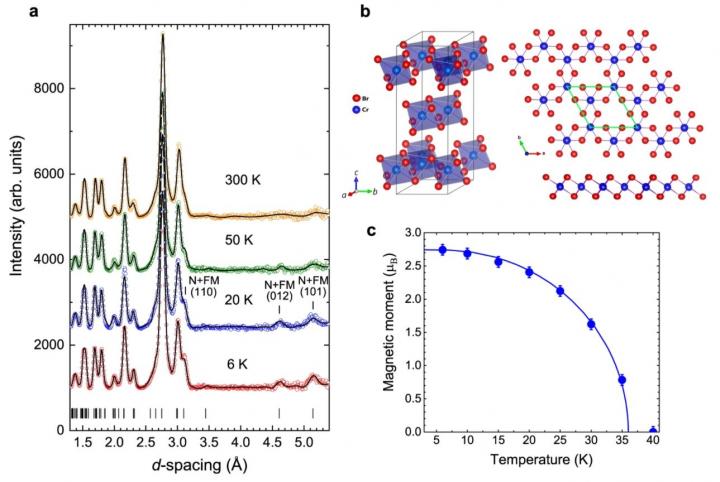A paper by Kazan Federal University and Joint Institute for Nuclear Research saw light in Quantum Materials

Credit: Kazan Federal University
Two-dimensional (2D) materials with a single-layer thickness retaining magnetic order in atomically thin limit began to increase their scientific and technological significance after the successful synthesis of graphene and later investigations of van der Waals materials. CrBr3 has been known since the 60s as a van der Waals ferromagnet. Hansen, Tsubokawa, and Dillon have pioneered the work on magnetism in this compound. However, it has only recently been established that CrBr3 exhibits ferromagnetism when exfoliating to several layers and monolayers while saving its magnetic order. Nevertheless, no systematic experimental data simultaneously investigating the temperature behavior of the crystal, the magnetic structure of CrBr3 have been reported in sufficient detail. This fact was the impetus for the team to perform studies.
The paper focuses on the investigations of crystal, magnetic structures and vibrational properties of CrBr3 upon cooling. The methods of neutron and X-ray powder diffraction supplemented by Raman spectroscopy data allowed the authors to provide a consistent and complete microscopic picture for a temperature behavior of microscopic properties of the model ferromagnetic van der Waals CrBr3 material. Neutron diffraction made it possible to study in detail the role of structural parameters across the paramagnetic-ferromagnetic phase transition in coupling with the study of the magnetic structure of CrBr3. Mainly, anomalies in the temperature behavior of the parameters of the crystal structure, interatomic distances, and angles below Curie temperature were revealed. The most important finding of the manuscript is the negative thermal volume expansion phenomenon observed in CrBr3 below the Curie temperature. The negative thermal expansion is the rare effect found for a limited number of materials. In addition, the obtained Raman data provide new information on temperature variation of vibrational modes across the transition to ferromagnetic state, uncovering spin-phonon coupling effects. The information about thermal expansion behavior is especially important for fabrication of heterostructures involving van der Waals materials and their practical applications. The obtained results of the work are very important for current understanding in the physics of 2D van der Waals materials and may serve as a background for subsequent theoretical calculations and development of general models describing the structural, electronic and magnetic properties of 2D ferromagnetic van der Waals materials in bulk and atomically thin forms.
The recently reported magnetic ordering in two-dimensional materials, such as chromium tribromide (CrBr3), opens new possibilities for fabrication of magnetoelectronic devices based on 2D systems, which can be also be combined in heterostructures. With the unusual magnetic properties and the possibility of existing in monolayer form, chromium trihalides are promising materials for ultrathin spintronics.
There is a number of still unexplored phenomena in this area. In the future, the researchers plan to investigate the structural and magnetic properties of CrBr3 under extreme conditions to improve the understanding of the observed physical phenomena. Van der Waals compounds with a different composition are also a promising topic.
###
Media Contact
Yury Nurmeev
[email protected]
Original Source
https:/
Related Journal Article
http://dx.




